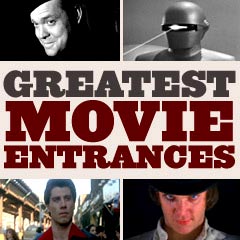
|
Entrances of All-Time 1956-1959 |
![]()
| Movie Title/Year and Film Character with Scene Description | ||||||||
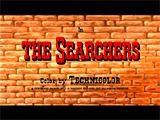
|
In John Ford's classic and landmark western, featuring breathtaking cinematography of Monument Valley, and set in Texas of 1868, the film opened with a dramatic horseback entrance. Loner, Civil War ex-Confederate soldier Ethan Edwards (John Wayne) returned to the solitary, Texas frontier farm of his estranged brother Aaron Edwards' (Walter Coy) family with radiant wife Martha (Dorothy Jordan), who raised her left hand against her forehead to shield her eyes from the sun. Aaron came out and stepped down from the porch, asking: "Ethan?" Everyone else expectantly watched and took positions on the homestead's porch, including Ethan's young 10 year-old niece Debbie Edwards (Lana Wood) and her older teenaged sister Lucy (Pippa Scott). The camera cut back and forth between views of Ethan and the expectant faces of the waiting family
Ethan's face was hidden by the low, broad brim of his black hat. He dismounted and wordlessly shook hands with his brother Aaron. Dusty from travel, he wore blue, yellow-striped cavalry britches. His sister-in-law, Martha greeted him: "Welcome home, Ethan." Then, he kissed her on the forehead - she closed her eyes during the reverential kiss. The children joined in the greeting. Martha swirled around in front of the door and entered backwards, drawing him also into the homesteader's cabin. |
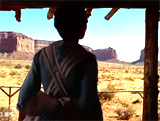 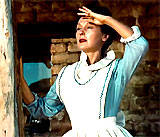 Martha Edwards (Dorothy Jordan) 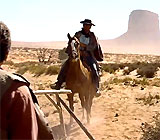 Approach of Ethan Edwards (John Wayne)  Aaron with Ethan |
||||||
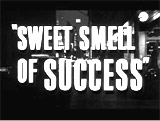
|
Sweet
Smell of Success (1957) In this drama tautly directed by Alex MacKendrick, beetle-browed, thick-spectacled, pallor-faced, power-mongering columnist J.J. Hunsecker (Burt Lancaster), a Walter Winchell-styled writer, was first viewed at the famed "21" restaurant in New York City. He was about to have dinner with politician-Senator Harvey Walker (William Forrest), the Senator's call-girl Miss Linda James (Autumn Russell), and her alleged agent-manager Manny Davis (Jay Adler). Hunsecker sat at a table revealing a steely, menacing and hulking presence with a skull-like, masked look to his crew-cut face (due to his deepened eye sockets caused by shadows from his magnified lenses). In front of him were a telephone, sheets of paper, and pen - for note-taking and collecting items for his column. He was interrupted by the arrival of sycophantic press agent Sidney Falco (Tony Curtis), who approached behind him. Hunsecker had hired Falco to besmirch the reputation of jazz guitarist Steve Dallas (Martin Milner), who was romancing Hunsecker's pretty sister Susan (Susan Harrison). Crew-cutted Hunsecker half-turned, noticed his lackey Falco, and then backhandedly insulted the currying press agent with a comment to the Senator seated with him:
|
  
|
||||||
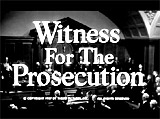
|
Witness for the Prosecution (1957)
In the opening of director Billy Wilder's twisting and turning mystery-drama (an intelligent adaptation of Agatha Christie's 1953 stage play, a courtroom thriller based on one of her short stories), redoubtable barrister Sir Wilfrid Robarts (Charles Laughton in a Best Actor nominated role) was returning home from the hospital after a two month stay for treatment of a heart attack. The irrepressible aging lawyer was accompanied by his fussy, overprotective and doting nurse Miss Plimsoll (Elsa Lanchester, Laughton's real-life wife) in the back seat of a chauffeured car. In the plot set in 1952's Britain, the crafty Sir Wilfrid would soon become involved in a criminal case - something not recommended by his doctors who wanted him to only take "bland civil suits." He was to behave by resting, ending his smoking of cigars and drinking of brandy, and regularly take his medication. The defendant in a pending case was unemployed American war veteran Leonard Vole (Tyrone Power), a seemingly-guileless and struggling inventor, who was charged with murdering wealthy middle-aged widow Emily French (Norma Varden) - there was only circumstantial evidence implicating him in the crime. Christine Vole (Marlene Dietrich), Leonard's enigmatic "wife" whom he had married after World War II, an East German former cabaret-beer-hall performer in Hamburg, made a dramatic entrance into Sir Wilfrid's front door just after the lawyer had learned the facts of the case and Leonard was arrested and charged. She had overheard Sir Wilfrid predicting her emotional reaction:
She countered his words when she introduced herself: "I do not think that will be necessary. I never faint because I'm not sure I will fall gracefully, and I never use smelling salts because they puff up the eyes." She assured him that she would be "disciplined" - and he was amazed by her "fortitude." She was insistent that Sir Wilfrid "personally defend" Leonard as "the champion of the hopeless cause," even though his health was questionable. She would ultimately provide Leonard with his sole alibi - that she was home with him when Mrs. French was murdered. |
   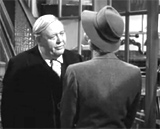
|
||||||

|
Horror of Dracula (1958, UK) (aka Dracula)
Talented director Terence Fisher's classic Technicolored Dracula horror film was the first of the UK's Hammer Studios' horror films about Dracula for the next two decades. After the title credits, the camera descended into a castle's cellar where it located a vault-crypt bearing the label: "DRACULA"; after a forward tracking shot, the label was covered with dripping blood from above. This was followed by an opening voice-over narration as a red book was opened:
Jonathan Harker (John Van Eyssen) had arrived at Castle Dracula, where he was posing as a librarian. He was first greeted by a buxom female (Valerie Gaunt, credited as Vampire Woman) begging him to take her away from her imprisonment by Dracula. This was followed by the memorable entrance of the dashing yet reclusive, blood-sucking and predatory Count Dracula (Christopher Lee) at the top of the stairs with his greeting to Harker once he descended and was pictured in a full-closeup: ("I am Dracula. And I welcome you to my house"). |
     
|
||||||
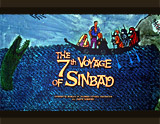
|
The 7th Voyage of Sinbad (1958)
One of the best known and most popular films of special-effects, stop-motion animation wizard Ray Harryhausen was this Technicolored, mythological-fantasy adventure. After creating many sci-fi creatures in earlier works, he now turned to mythology and swashbuckling adventure. This landmark film with great innovative creature effects (now called Dynamation) was the first of three Sinbad adventures, also including The Golden Voyage of Sinbad (1973) and Sinbad and the Eye of the Tiger (1977). In between this film and the second Sinbad film, Harryhausen's films with special visual effects included:
In this fanciful tale by director Nathan Juran, adventuresome handsome sailor Sinbad (Kerwin Mathews) and his crew - on the mysterious island of Colossa with evil and wily bald magician Sokurah (Torin Thatcher), were assaulted by a giant one-eyed mythical monster. It was the Cyclops, a great two-legged beast with a rhino-like horn from the top of its head, furry satyr-like legs, cloven hooves, and three-fingered claws at the ends of its strong arms. The creature's upper torso was reptilian and rigid, and its back had pronounced spinal ridges. They were chased from the island-cave lair of the beast back to their vessel, although were able to spear the ferocious creature in the chest a few times. Sokurah called upon his prized possession - a magic lamp (with a boyish Genie or jinni named Burani (Richard Eyer) inside) to create a magic barrier between them and the Cyclops. It was successful and the group escaped to the safety of their boat. As they fled, however, the Cyclops threw a boulder at them, and their boat sank. The magic lamp was lost to them and acquired by the Cyclops. The treacherous sorcerer later forced them to make a return voyage to Colossa, to retrieve his magic lamp. Sokurah claimed that he could restore miniaturized Princess Parisa (Kathryn Grant) to her normal adult size with a vital ingredient found on Colossa - a piece of eggshell from the giant bird known as the Roc. During his second dangerous voyage, Sinbad would again encounter the threatening Cyclops.
Sinbad hired a group of criminals from the Bagdad prison for his new crew, who soon turned mutinous. In the valley of the Cyclops on Colossa, they found the treasure hoard of the monster. In a battle with the beast, three sailors were caged and one of them was barbecued on a spit, and three of the men were crushed under uprooted trees. Sinbad was able to blind the Cyclops with a burning stake-brand impaled into its eye. The unseeing, stumbling monster was lured to the edge of a cliff by Sinbad, where it fell to its death. |
      First Encounter with Cyclops |
||||||
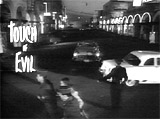
|
In actor/director Orson Welles' classic crime noir, corrupt Texas border-cop Hank Quinlan (Orson Welles) was a fanatical, redneck, unshaven, obscene monstrous character with no redeeming value. The thriller opened with the car bombing of Rudi Linnekar, an American building contractor. The District Attorney Adair (Ray Collins) made the first few remarks about Captain Quinlan, the local cop who had not yet arrived for the investigation at the deadly crime scene: "Old Hank must be the only one in the county who didn't hear the explosion." Adair also called Quinlan "our local police celebrity." Quinlan was obese and whale-like at almost 300 lbs -- first viewed below eye level as he struggled to pull himself out of the back seat of a car that had pulled up. He was there to conduct the investigation of the car bombing in his jurisdiction. Appearing with a vast paunch and slovenly dressed in a massive gray raincoat and wide-brimmed hat, he was chomping on a cigar as he began to speak. |
  
|
||||||

|
The revelation scene of Madeleine (Kim Novak) in Ernie's restaurant in San Francisco was integral to the twisting plot -- Gavin Elster (Tom Helmore) was joined at a table with the lovely, elegant, and beautiful blonde Madeleine wearing a dark, nakedly-backless evening dress with green trim. While the camera moved toward their table, Madeleine's back was kept toward the camera. As she left the restaurant, Scottie Ferguson (James Stewart), half in profile, had his nervous, "ghostly" first encounter with the woman. His first view of the beautiful female was incredibly transcendental. She was half-seen in a close-up profile as she deliberately paused behind him, to display herself to him, and awaited Elster, with the radiant light reflecting off her hair. |
 
|
||||||

|
Sweet Sue and her Society Syncopaters, an all-girl jazz band, was traveling to Miami, Florida by train. Dressed in drag and joining the band were two hapless musicians Jerry/Daphne (Jack Lemmon) and Joe/Josephine (Tony Curtis), to escape execution by mobsters after witnessing the St. Valentine's Day Massacre. As they walked down the train platform, they noticed the band's ukelele-playing, voluptuous singer, hip-swinging 24 year-old blonde Sugar Kane Kowalczyk (Marilyn Monroe) behind them. As she passed them in her high heels, they scrutinized her figure. Sugar's introductory appearance objectified her sexuality as the camera focused on her legs and swiveling rear - also filmed from behind when she passed. She jumped aside and picked up her pace when the train squirted her rear end with hot steam. Jerry marveled at Sugar's wiggly walk in a memorable line:
|
   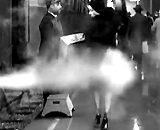 
|
||||||
(chronological, by film title) Introduction | 1920s-1935 | 1936-1939 | 1940-1945 | 1946-1949 | 1950-1955 | 1956-1959 | 1960-1965 | 1966-1969 1970-1975 | 1976-1979 | 1980-1985 | 1986-1989 | 1990-1995 | 1996-1999 | 2000-2005 | 2006-Present |